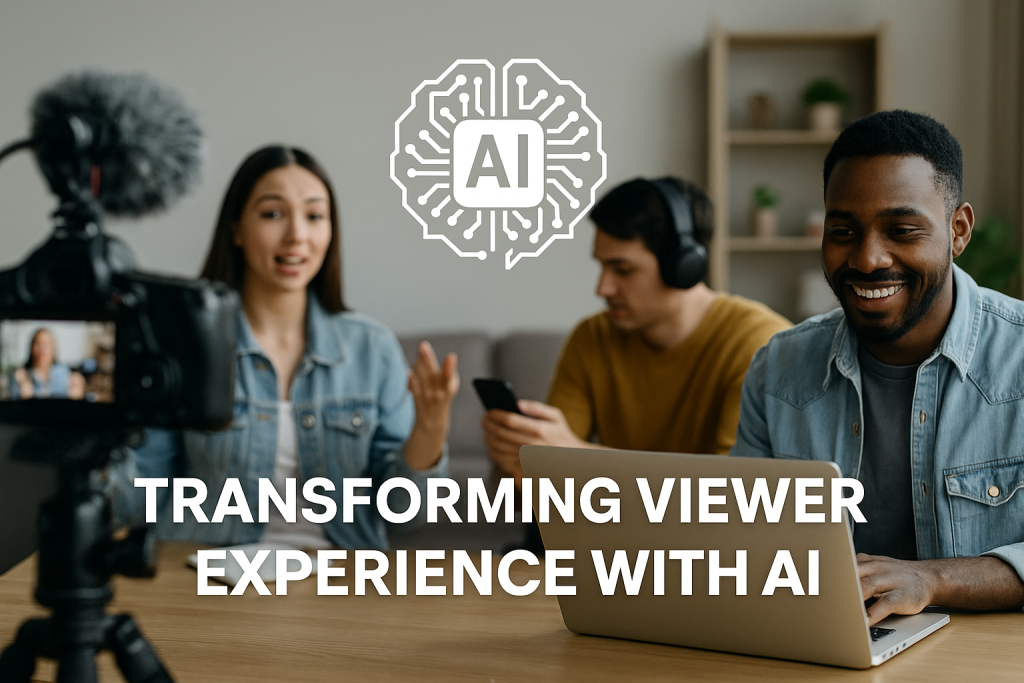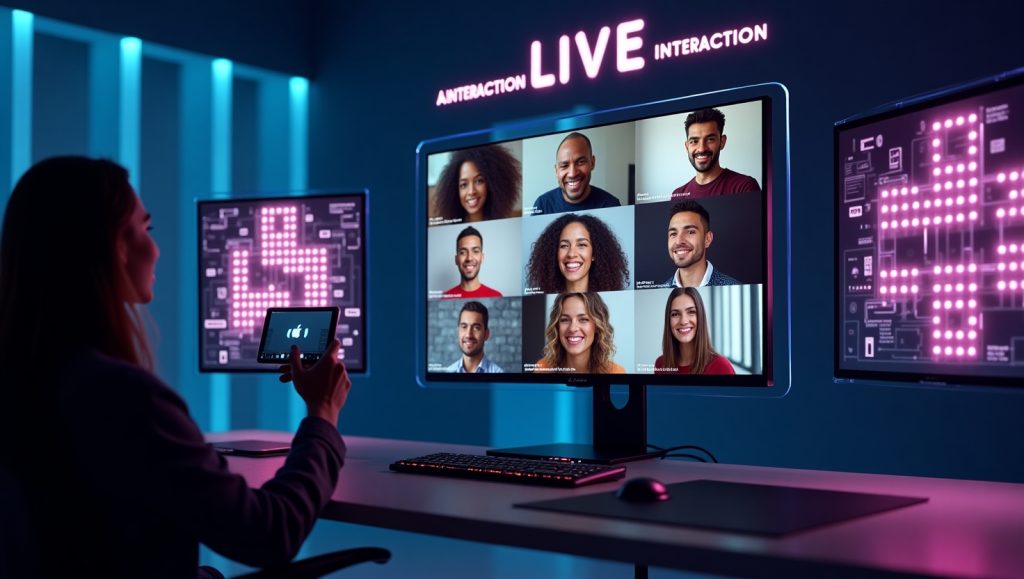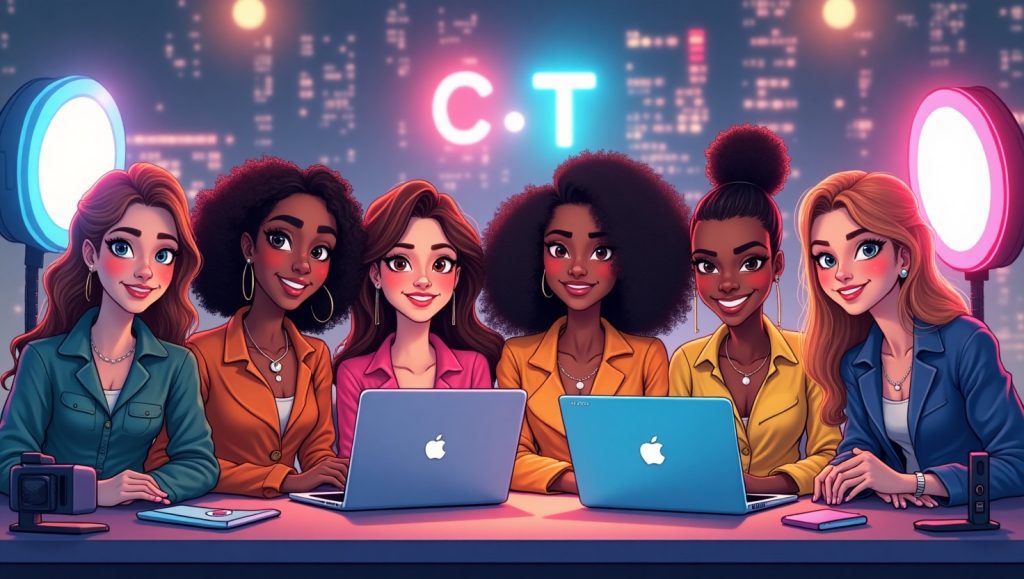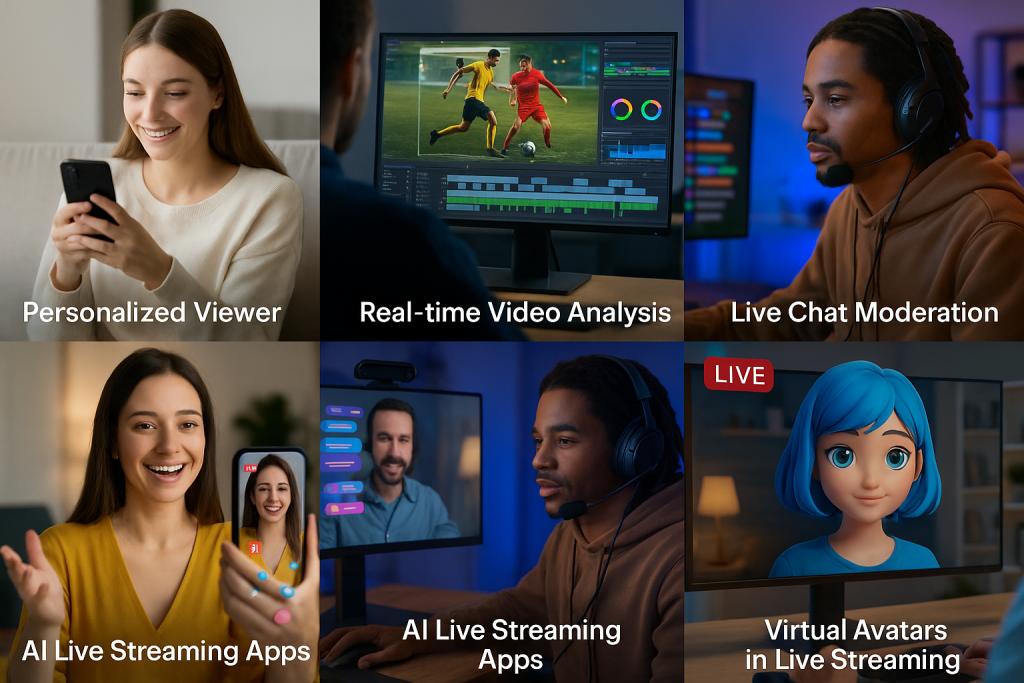
In the last few years, live streaming has emerged as the very form of digital communication that changes the ways in which we share, consume, and interact with audiences across the globe. In this revolution is found AI in live streaming, not an ordinary element, but indeed revolutionary, pushing aside the limits of possibilities[Hs, 2.10.2] by integrating state-of-the-art technology to improve the viewer experience, ease up the content moderation, and allow broadcasting with an exceptional level of interaction. Everything, from AI live streaming TikTok videos attracting millions, to innovations with AI live streaming apps all over China, is putting artificial intelligence on the shape of redefining the real-time video deliverance.
Table of Contents
The discussion will be comprehensive into many aspects of it, which is AI in live streaming. AI powered tools will be reviewed for personalizing viewer engagement, providing content optimization using highly advanced graphics, virtual avatars, and improved effects, as well as real time analytics for content optimization. In addition, many important topics like automated content moderation, speech recognition, audience analytics., and future trends molding this industry further will also be examined. Anyone from content creator, platform developer or just an enthusiastic viewer, learning about these innovations would bring precious knowledge into the future of live broadcasting.
Introduction to AI in Live Streaming
This relatively young yet ever-evolving field of study involves the marriage of real-time content with intelligent automation and personalization. Historically, most live streaming platforms have relied on manual back-end moderation with static content delivery and the simplest possible interactivity. Today, these platforms are becoming increasingly smart, interactive, and safer environments for creators and audiences with the help of AI tools.
AI in live streaming includes many enabling technologies to allow broadcasters to analyze large data sets as they flow in and personalize user experiences in real-time while creating immersive virtual environments for engaging viewers. With a growing demand for real-time high-quality, interactivity, and safety into shows, we are left with no option else to steer AI into bringing the mainstream adoption-from AI live score updates in sports to streaming links for Ind vs Aus; the flow of influence of AI is through all facets of live broadcasting.
Keeping abreast with the trends in AI and live streaming would help stakeholders appreciate the development trends within which these improvements fit into a larger pattern of consumption across the media. While AI embeds efficiency, it embeds authenticity and engagement, ultimately creating loyal communities around live content.
Overview of Live Streaming Technology
Streaming live video, which involves the capturing of live video events, digitization of the feed, and delivery over the internet for immediate consumption, takes advantage of a complicated ecosystem of cameras, servers, CDNs, and human interfaces. Improvements in bandwidth, compression algorithms, and device specifications have greatly increased accessibility and quality with respect to live streams.
Sessions with ultra-high definition streams, low-latency broadcasting, and instant multi-device compatibility, and moreover, the above technical aspects capture any emerging technical challenges like moderation, personalization, and interactivity that will rely heavily on AI.
Live streaming technology has also been aided by AI by helping with the automation of various operational aspects, such as content filtering, chat moderation, and dynamic adjustments of content according to viewer behaviour. It provides real-time analysis of data streams to broadcasters, allowing them to make instantaneous decisions that improve both quality and engagement.

The Role of Artificial Intelligence in Media
Artificial intelligence introduces machine learning (ML) algorithms, natural language processing (NLP), computer vision (CV), and speech recognition (SR) systems into the media ecosystem. Each of these capabilities helps media platforms perceive, receive, and respond to live content and audience participation that was previously unthinkable.
For instance, AI can identify violating comments, unsuitable comments, or any flagged content during a live stream and ensure compliance with community standards. AI is the basis for personalized recommendations, tailoring streams specific to perception (finding) based on viewer interaction and perception engagement and memory or awareness. AI also aids in generating subtitles, translating content, and reporting on audience sentiment by analyzing notes in real-time.
If media workflows embed AI, content providers can increase audience experiences to make them richer, safer, and more relevant turning passive viewers into active participants delivering ultimately increased interactions. As technology and AI become more prominent, its ability to learn, analyze, predict, and suggest will become even more critical to the future of live streaming.
Current Trends in AI and Live Streaming
A few trends reflect the growth of AI’s role in live streaming:
Automated Content Moderation: AI-powered moderation bots or filters control extensive chat or commentary functions in real-time, which can minimize hate speech or spam.
Personalized Viewer Experiences: Larger-scale recommendations and customized or personalized interfaces can create deeper engagement based on personal preferences.
Interactive Virtual Environments: Avatars (virtual, augmented, and mixed realities) can produce more immersive interactions around live events.
Real-time Video Analysis: Computer vision analysis around live-streamed footage can include scene detection, visual effects, or viewer reactions per second.
Crowd Analytics: Data mining allows for a greater understanding of an audience’s demographics, preferences, and levels of engagement, which helps strategize future events.
The examples we presented suggest that innovations catalyzed by smart technology will continue to change our engagement with live streaming environments, and in turn, be influenced by viewer demand for safer, smarter, and enhanced live streaming ecosystems.
Transforming Viewer Experience with AI
The true power of AI in the live streaming space is in transforming watching from simply the passive act it traditionally is to a far more enhanced viewer experience. Using complex algorithms, the platforms can produce content which is attuned to the user’s tastes, encourage interaction, and ensure everyone’s safety. The whole point is to provide every viewer with a personalized, enjoyable, and seamless engagement that keeps them invested and excited to come back.
The possibilities of AI give broadcasters the ability to show the viewer what they want to see, offer new content aligned to their previous choices, and generate a real-time interaction that can feel similar to a face-to-face interaction. All while they are engaged in the activity of watching content. These advancements are about more than playing content-they are changing how communities are built and monetized and the whole social aspect that goes with it.
Personalized Viewer Experience
One of the most interesting ways AI can be used is to personalize a viewer experience. This involves employing various machine-learning models to analyze various user datasets typically organized by viewing habits, search queries, and history of interactions, which allows platforms the ability to extrapolate correlated content that specifically creates a unique viewer experience for individuals. One of the prime applications of this personalization is the TikTok variant of AI live streaming, offering suggested streams based on users’ previous interactions, effectively creating a personalized feed that caters to user preferences.
Personalization in platforms like TikTok not only encompasses content suggestions, but plays a part in interface design, notifications, as well as interactive functions catering to each individual viewer. A personalized experience promotes a deeper emotional connection between the content and the users, if viewers have a sense of being known and catered to, they will spend longer amounts of time on the platform, engage more regularly, and develop loyalty to the platform. For creators, AI insights will ultimately hone their content strategy in an evolving way that caters to the users changing interests
. In addition, ai tools could be used to instantly change stream layouts or call attention to highlights based on viewer reactions to create a user experience that represents co-creation or active participation. Adaptive forms of personalization not only engage viewers, but innovate engagement by morphing viewing from an observation to participation, ultimately changing traditional broadcast standards.
Dynamic Content Recommendations
Dynamic content recommendations are essential to all modern live streaming ecosystems. With real-time data ingestion and analysis, AI-based recommendations analyze viewer behavior across a variety of engagement interactions such as clicks, likes, comments, and duration to recommend relevant streams, clips, or interactive elements.
For example, as viewers watch or live stream ind vs aus link, AI algorithms determine the level of interest or engagement based on how the audience interacts in real-time with elements on the platform and recommend additional content or merchandise, or other linked streams based on interest level and context, so a person keeps looking, increases the length of time spent on that platform, and can monetize off increasingly engaged contractually-re properties.
As accurate recommendations rely on analytical models that can identify patterns and flexibly switch recommendations, AI is still developing its models of viewing predictions, and platforms can proactively front the content to a viewer before they even have to search it explicitly, which increases chance of satisfaction with service and engagement length, and subsequent continued viewer retention.
In addition to recommendations, personal notifications, personalized ads, and personalized promotions, ads, notifications, are vital for monetization. Platforms that create dynamic property content suggestions can build user loyal communities, increase user life-time value, and remain competitive in an increasingly busy market.
Interactive Broadcasting Tools
Interactivity has quickly become an essential part of live streaming today thanks to AI-powered tools that allow participation, rather than simply viewing, of audiences. Live interactive features including live polls, Q&As, virtual gifting, and broadcast events with co-hosts use AI as an interactive engagement tool for audiences by reducing friction in the experience looking for engagement rewards and value.
AI moderation bots and chat bots also ensure positivity in chat interactions for audiences, allowing viewers a welcome space to speak and connect positively. AI also improves intelligent moderation at scale for large audiences from the traditional human moderators, reducing the burden on human moderators.
AI is not only valuable for moderation but can also be used in other interactive broadcaster tools like overlays, backgrounds, and AR effects that respond to prompters and viewers alike. These tools boost elegance and professionalism, fun and novelty and share friendliness to streams.
In addition to entertainment, AI interactive can also enhance education, corporate events and fund raising events, creating tele-everything (tele-education, tele-communications and tele-social) possibilities. As these tools continue to rapidly evolve and improve, we won’t just see the lines blurred between content creator and content consumer, but also the participatory media experience that has started a new adventure in content delivery.

Enhancing Content Delivery through AI
In regards to live streaming, the importance of content delivery is still paramount to success. With AI, broadcasters can embrace the new frontier of content delivery that goes beyond traditional experiences with real-time analytics, automated effects, and immersive environments. This section discusses the ways AI-powered innovations are making streams more dynamic, professional, and engaging.
Real-time Video Analysis
Real-time video analysis applies computer vision techniques to interpret live footage instantly. It enables features such as automatic scene detection, visual effect application, or audience reaction tracking. This is convenient for sports broadcasts, concert productions, or game streaming if you want to engage with your audience quickly based on visual cues from this content.
In sports broadcasting, for example, during an AI live score update, AI can analyse the game footage a moment after a goal, foul, and other significant events. AI could overlay real-time stats and highlights that occur trans-nationally based on some performance threshold or character recognition. This advanced level of integration appeals to spectators because it connects the visual action in live sport to engaging, informative production.
In addition to event detection, real-time analysis might also determine the quality of camera feeds by detecting issues related to the operator’s focus or lighting, and let them know they should adjust their settings immediately. This means producers will achieve higher quality productions and higher levels of audience satisfaction in real-time.
The operational challenge of real-time video analysis is processing massive amounts of data, while keeping latency very low, which requires advanced hardware resources and optimized algorithms to ensure this is efficient. As AI systems get faster and more accurate, we should further anticipate more applications that have great potential to offer professional-grade content for content providers and streamers alike.
Audio and Speech Recognition
Audio and speech recognition technologies can be century-defining for live streaming, enabling things like hands-free voice commands and automatic subtitles or multi-language translation. These technologies eliminate the barriers to engagement, increasing accessibility to a larger audience and increasing engagement.
For broadcasters, speech recognition allows the presenter or content provider to control the various aspects of streaming without needing hands, allowing for more fluid presentations while engaging in an active event or while multi-tasking. For viewers, particularly during live streams, the AI-generated captions assist in better comprehension, especially while there are background noise or if someone is not a native speaker.
When engaged in streaming internationally, the AI-powered translation tools can convert speech into multiple languages almost instantaneously, extending the audience on a global stream. This is especially useful when considered in the context of AI live streaming in China, where streaming can have audience diversity issues caused by a language barrier.
Audio analysis may also quantify the audience’s emotions and sentiment when watching with engagement, allowing facilitators or hosts to alter their message delivery instantaneously. The combination of speech recognition and natural language processing may foster an interactive atmosphere where the AI recognizes viewer interaction (or lack thereof) and stimulates chat moderation by responding to viewer interactions in sophisticated ways.

Enhanced Graphics and Effects
Visual aesthetics are important for getting audience attention. AI is improving graphics and effects with solutions such as deep-learning-based image enhancement, virtual backgrounds, and augmented reality overlays. These technologies provide streamers with the ability to have professional quality visual effects without the need for film and extensive post-production.
For example, AI-powered virtual avatars can allow broadcasters to ensure anonymity or to transpose their fantasy on their streams. AI-facilitated facial recognition and body motion tracking are enabling streamers to create dynamic animations and on-screen effects in symphony with the streamer’s gestures or facial expressions in real time.
Improved graphics are not only available in the entertainment industry; but in the education sector, or e-learning tutorials, product demonstrations, and corporate webinars. AI will help to create overlays that generate in real time with audience engagement or dynamically change based on contextual information–in real time, as a part of the original broadcast.
As AI and video generation solutions become more sophisticated in the future, the potential to create immersive experiences and visually compelling streams will expand at exponential rates – giving creators the ability to engage and reiterate an audience using visual communications.
Ensuring Safe and Engaging Environments
Establishing a secure, inviting, and proactive environment is essential to ensure the sustainability of live streaming platforms. AI solutions are a key component for moderating content, managing large audiences, and maintaining community standards, enabling trust and safety.
Automated Content Moderation
AI moderation (automated moderation) involves artificial intelligence algorithms that scan and analyze live content, often alongside live-stream interaction (streaming chat) to find inappropriate content (pubicly acceptable standards). Specifically, this could include things like hate speech, spam, or harassment. Ideally, the AI system could respond immediately, removing harmful content from the audience’s experience before it has chance to be absorbed.
As live streams are so massive and fluid, and incapable of being moderated by a user (relying on deliberately placed human moderators, such as a small group to manage thousands or millions), the use of automated moderation is a necessity! AI models (shadow moderation) trained on incredible amounts of data can identify and recognize patterns related to harmful or offensive (toxic) language, images or behaviours, leading to reduced occurrences of toxicity within the same content.
However, in order to build effective AI moderation systems, a big challenge is ensuring the moderation system/model remains sensitive yet fair, the system could be too sensitive and moderate down or restrict a legitimate discussion or could fail to moderately regulate and continue and allow harmful or forbidden content. Continuous (forever) adjustment and updating of models, with a huge focus including context-based models, will be required to ensure the right level of moderation.
In markets like China, where AI live streaming will face strict regulatory requirements, automated moderation will aid platforms in meeting legal regulation, while simultaneously maintaining credibility with viewers. As capabilities of AI increase, moderation will follow along that path, to support the needs of different cultural norms and community expectations.

Live Chat Moderation
Live chat is an essential part of interactive streaming, but with the amount of messages that can come in each second, this aspect can turn into a bit of a nightmare. AI chat moderation tools can automate filtering spam messages, inappropriate language, or unwanted links, all in order to keep the chat a substantive and respectful conversation.
These AI chat moderation systems are able to parse natural language, giving them the ability to find context, know when a joke was made or they are meant to respond to an insult, and they can also customize specific filters. Some platforms will even use real-time sentiment analysis measures, pausing that analysis to the overall chat to determine if moderators or hosts will need to intervene, should negativity ramp up.
AI Chatbots can also work with your viewers to engage them, answer common questions, or help promote content, lessening the burden that moderators have and helping improve the overall user experience in the chat. More often than not, the bots are programmed to filter in to human moderators when needed, and offer a hybrid solution of automation and human decision making.
Using AI in your live chat moderation makes it feasible to manage the chat in a scalable, efficient, and respectful manner that is necessary to foster healthy online communities.
Crowd Analytics
Knowing audience characteristics, behaviors, and engagement trends is essential to content strategy and platform development. AI powered crowd analytics assesses chat logs, view times and other social media activity to develop reports with actionable insights.
Through clustering, classification and predictive analytics are used to identify trending topics, peak talking times, and user expressions, informing platform content and timing, and marketing campaigns.
Crowd analytics can also assist in identifying patterns of coordinated inauthentic behavior or bot activity, which can distort audience measures. Once brands and creators understand who to distinguish organic engagement from, they can build genuine communities around their content and optimize monetization.
When demographically segmented, crowd analytics can accelerate targeted advertising and improve audience personal experiences thereby increasing platform revenue and improving the user experience. It is positive signals that the sophistication of AI driven analytics will allow us to move towards new understanding and servicing a rich tapestry of diverse audiences.
Innovations and Future Directions
The world of AI in live streaming is constantly evolving, thanks to technological advancements and changes in consumer expectations. Some interesting examples of evolution include dedicated AI live streaming applications, virtual avatars, and particularly strategic case studies in China on how AI is changing global content creation.
AI Live Streaming Apps
Specialized AI live streaming applications include advanced features such as auto-editing, real-time effects, automated content curation, etc. They empower everyone from amateur users to professional creators to create high quality polished streams with little technical experience.
Some applications offer AI capabilities automatically optimizing lighting, sound quality, scene transitions, etc., helping to maintain consistent quality throughout the stream. Other applications offer AI powered analytics to help the broadcaster improve engagement or maximize reach.
The unique combination of app-based AI live-streaming technologies create community. Most apps have built-in social features along with virtual gifts and monetization methods.
Being on the leading edge of AI live-streaming as it relates to edge computing, and its use of 5G networks to reduce latency, will only improve future iterations of live-streaming apps.
Virtual Avatars in Live Streaming
The virtual avatars represent quite an interesting area of AI technology they allow hosts to appear as digital avatars, where those avatars can do sophisticated gestures, facial expressions/emotions, or entertain audiences all without being physically present. The digital avatars engage in a deep learning and motion capture process to look increasingly convincing and animated.
With AI live streaming China, virtual avatars pour into e-commerce as they pour into gaming, entertainment, and all media that claim to be a bit different from traditional broadcasting, and thus the avatars claim a varied way for audiences to watch, interface and engage. A virtual avatar affords real-time multilingual engagement, anonymity, and user-friendliness and at time has the likeness of the avatar without representing the avatar!
There are also enormous opportunities to grow creatively with virtual avatars, along with some logistical challenges, such as any associated health concerns, scheduling commitments, or distance constraints, that make using a live digital avatar easier and more accessible in live streaming.

Case Studies: AI Live Streaming in China
China has seen rapid growth in the adoption of AI in live streaming, with platforms at the front edge implementing advanced tools to improve content quality, safety, and interactivity. Companies are using AI for real-time moderation, personalized recommendations, and the development of virtual influencers. For example, some Chinese platforms have AI powered virtual hosts that can interact with viewers as though they were human, but they may also be answering questions, or performing scripted segments
. These virtual hosts may be featured in marketing campaigns, or entertainment shows, drawing large audiences. Crowd analytics are providing Chinese platforms with the ability to use data to understand regional differences, customize content accordingly, and optimize customer experience. In addition, the government’s strict regulations incentivize Chinese platforms to rely on automated moderation to help ensure compliance. These case studies highlight the tactical reasons of integrating AI, not only in a way to enhance the user experience, but to preserve opportunities for operational efficiency and to remain compliant with regulatory requirements.
Conclusion
The introduction of AI to live streaming is transforming how content is produced, delivered, and experienced. Its influence is significant, and its applications are broad; from customized viewer experiences and shifts in recommendation systems to the use of augmented effects and moderated moderation. Furthermore, the live streaming landscape is always evolving with innovative and transformative technologies including virtual avatars, real-time tracking of video performance, and advanced crowd analytics. The industry is positioned to contextualize these advances in more meaningful and impactful ways than are currently available.
By adapting these new technologies in more creative and expansive applications, Content Creators and Platforms will not only be able to offer safer and more engaging live broadcast experiences; they will be able to offer an interesting and customized value for all users in a way that has never been done before and will elevate the global live streaming industry into a new level of interactive entertainment.

FAQS:
In what manner is AI changing live streaming today?
AI is changing live streaming with personalized content, real-time analytics, interactive tools, and automated moderation. It enables platforms to provide more intelligent, safer, and engaging broadcasts.
What are the perks of AI for live stream content creators?
AI helps creators with auto-enhancing visuals, moderating chats, suggesting content, and even evaluating virtual avatars to present their voices. This allows for greater efficiency while still reaching niche target audiences and monetization opportunities.
Can AI increase viewer engagement during a live stream?
Absolutely. Engagement through AI will come in many forms, including real-time polling, dynamic content suggestions, personalized notifications, and real-time measurement of live sentiment all adjusting the experience to keep audiences engaged.
What are AI-driven virtual avatars and how are they being used in live streaming?
Virtual avatars are Houston-generated digital representations for streamers to engage with audiences where they do not have to present physically. Avatars are widespread in entertainment, education, and e-commerce in markets where people do not wish to expose themselves to a live streaming audience, especially in China.
How is AI assisting content moderation in live streaming?
AI has the capacity to identify and filter inappropriate comments and hate speech in real-time because they generally have confidence in their ability to understand the context in which that chat occurs. This creates a safer chat room environment and protects the platform and streamer from liability to satisfy platform policies and government regulations especially in markets like China.
What tools use AI to improve the quality of live video and audio?
Several live streaming services and AI apps are providing features like real-time speech-to-text, background enhancement, voice commands, auto-correction of lighting if the video is brightness- or color-edited and AR-based effects to enhance the consistent quality of the content.
What are the future trends of AI in live streaming?
The future trends include hyper-personalized streams, multilingual AI avatars, AI-powered production studio, deeper analytics (both descriptively and efficiently), and edge computing to approach ultra-low-latency live experiences.


Very informative article 👍
Good job
Excellent
God is the better